- Virtual Reality Will Become the Norm
- Consumer Demand for Sustainability Will Impact ECommerce Businesses
- Sellers Will Need to Optimize for Mobile Commerce
- ECommerce Will Depend on Social Media & UGC
- Personalization Is the Future of ECommerce
- Brands Will Need to Put Effort Into Data Security
- Voice Search Will Grow in Popularity
- Everything Will Be Automated
- Chatbots Will Communicate With Customers and Save Sales
- Customers Will Expect AR and Emerging Technologies on ECommerce Websites
- Live Shopping Will Be the Next Big Thing in ECommerce
- Online Payment Options Will Increase
- Payment Processes Will Be Faster
- Artificial Intelligence and Machine Learning Will Be Widely Used
- Omnichannel Retail Will Give Customers a Seamless Shopping Experience
- Video Marketing Will Play a Big Role in ECommerce
- SEO Will Be a Cost-Effective Marketing Strategy
- Decentralized Marketplaces Will Emerge
- Recommerce Will Be a Big Trend
- Brands Will Need to Optimize for Fast Performance
- SMS Marketing Will Take Off for Small Businesses
- Subscription Business Models Will Be Popular
- Headless Commerce Will Take Over
- Funding For Your 2023 Growth Goals
What’s on the horizon for eCommerce? Well, it’s hard to know for sure. ECommerce is still a relatively young form of retail, and as such, it’s constantly growing and changing.
Accelerated by the 2020 Covid-19 pandemic, eCommerce sales have skyrocketed in recent years. In fact, by the end of 2023, experts predict that global eCommerce sales will exceed $6.3 trillion, accounting for more than 1 in 5 retail sales worldwide.
The continued growth of eCommerce seems pretty certain, but what else can we expect to see change in the next year?
We asked eCommerce sellers and experts from around the world what they predict will happen in the world of eCommerce in 2023, and got a wide variety of answers. Here are 23 of the top predictions we heard about where eCommerce is headed in the next year.
1. Virtual Reality Will Become the Norm
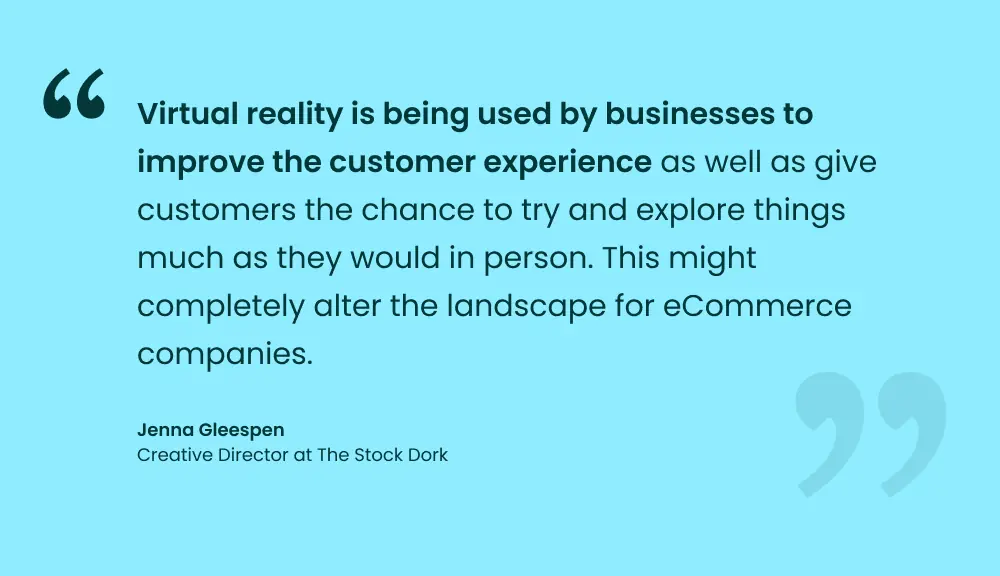
Virtual reality, or VR, is becoming more and more widely used across industries and applications. Put simply, virtual reality is a computer generated environment that gives users an immersive experience. When it comes to eCommerce, VR can be used to give shoppers a completely immersive shopping experience while browsing online.
In fact, Jenna Gleespen, Creative Director at The Stock Dork, predicts that VR “might completely alter the landscape for eCommerce companies” in 2023.
“Experiences with VR and AR can change how online customers view the goods they plan to purchase,” she explained. “You may give customers a better understanding of whether the products meet their requirements by showcasing them in virtual reality.”
This has the potential to be a huge draw for customers. After all, if you can virtually try on a size and color in an online store, it eliminates one of the biggest benefits of shopping in person.
“Virtual reality is being used by businesses to improve the customer experience as well as give customers the chance to try and explore things much as they would in person,” Jenna told us. Any eCommerce brand with such technology will have an advantage over their competitors.
Subscribe to the eCommerce newsletter for
top industry insights
2. Consumer Demand for Sustainability Will Impact ECommerce Businesses
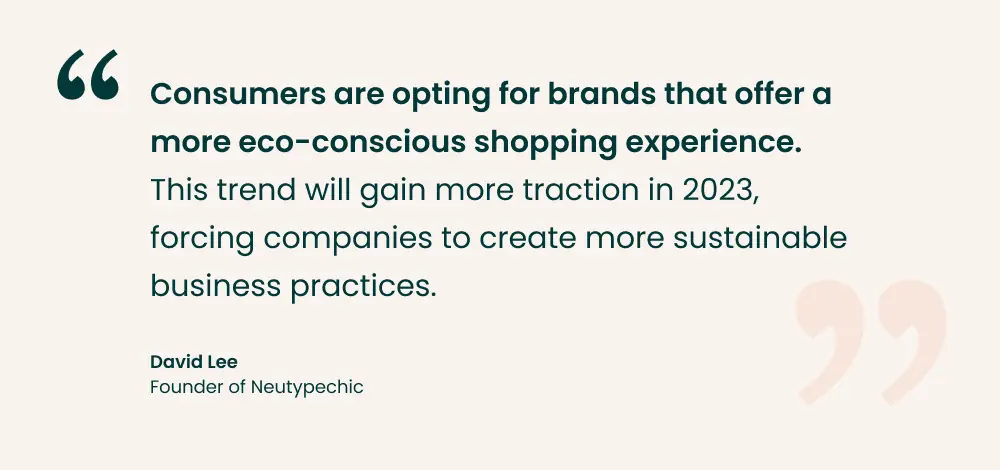
As environmental awareness spreads through the mainstream, a growing number of consumers are making buying decisions with sustainability in mind. If eCommerce businesses want to keep up, they need to adapt to these growing demands.
David Lee, Founder of Neutypechic, America’s leading mirror brand on Amazon and Wayfair, predicts that 2023 will be the year when the environmental trend will really take off.
“Consumers are opting for brands that offer a more eco-conscious shopping experience,” he pointed out. “This trend will gain more traction in 2023, forcing companies to create more sustainable business practices.”
Consumers are intentionally seeking out environmentally sustainable brands, or those with transparent policies that are actively attempting to become more eco-friendly. Therefore, “brands need to take action to acclimatize to the rise of green consumerism,” David advised.
David credits the Covid-19 pandemic, at least in part, for this change in consumer behavior.
“Shoppers are willing to pay more to buy sustainable products despite financial fears,” he said. “It is because of the pandemic, as 52% of consumers say that they value sustainability more because of the pandemic. Whereas, three out of ten consumers say that environmental factors impact their purchasing decisions.”
3. Sellers Will Need to Optimize for Mobile Commerce
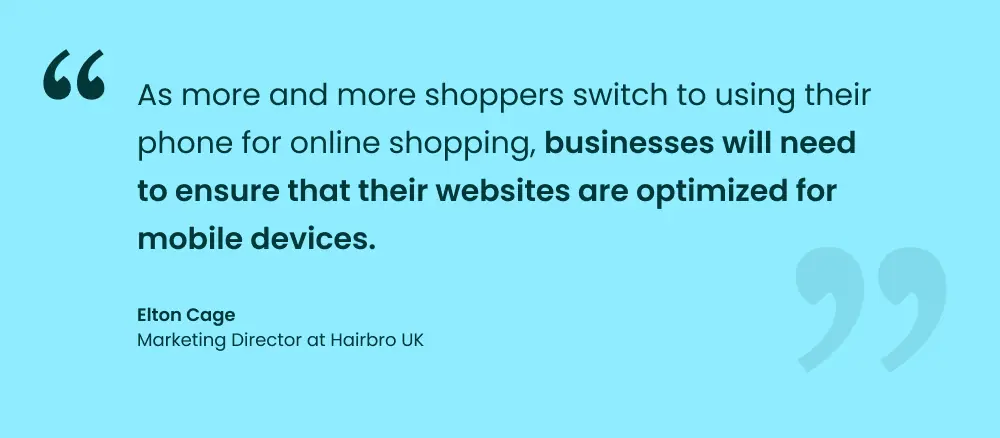
Everyone has a smartphone these days, and they spend hours upon hours every day scrolling through social media, consuming content, and making purchases from this mobile device. As people make the shift to shopping from their smartphones instead of turning to desktop computers, eCommerce sellers will need to make sure that their mobile experience is up to par. Otherwise, they’ll miss out on many sales opportunities.
Marketing Director at Hairbro UK Elton Cage predicts that eCommerce businesses will need to make sure they’re ready for this growth in mobile commerce in 2023.
“ECommerce will become even more mobile-friendly,” he forecasted. “As more and more shoppers switch to using their phone for online shopping, businesses will need to ensure that their websites are optimized for mobile devices.”
It’s no secret that online stores look different on a smartphone screen than they do on a desktop, so it’s important that brands put in the necessary effort to make sure the mobile experience works properly.
“This means making sure that the site is easy to use, with quick load times and a seamless checkout process,” Elton clarified.
4. ECommerce Will Depend on Social Media & UGC
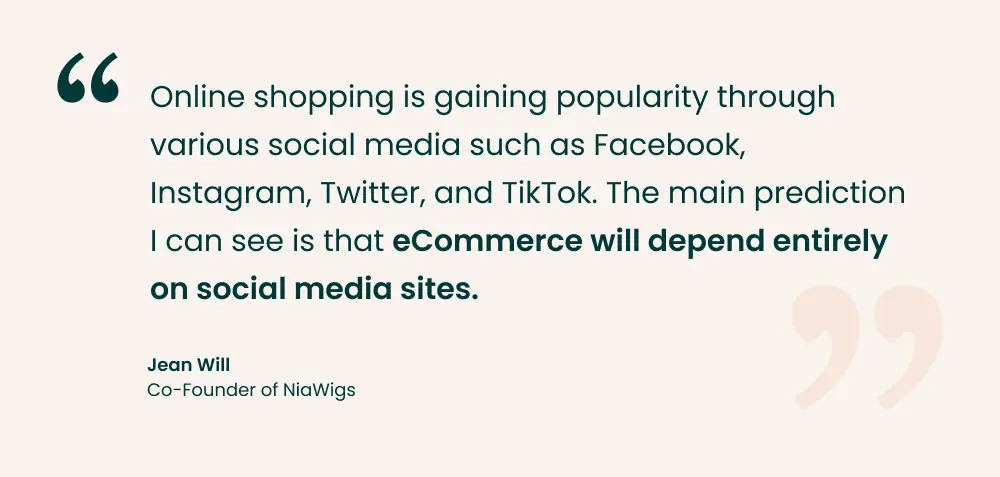
One of the biggest changes over the past decade has been the rise of social media, and it isn’t going anywhere any time soon. Wherever you go, you’re bound to see people walking around with their noses in their smartphones. Chances are, they’re scrolling through social media.
With 4.7 billion users each spending an average of 2 hours and 29 minutes on social media every day, it has become one of the most important spots for eCommerce marketing. Businesses have the opportunity to reach huge markets through outlets like Facebook, Instagram, and TikTok, referring traffic to their websites, advertising products, and increasing brand awareness. Plus, they can even interact with their audience, building brand loyalty and giving consumers input into product launches and other brand decisions.
Jean Will, Co-Founder of NiaWigs, predicts that in 2023, “eCommerce will depend entirely on social media sites.”
“Online shopping is gaining popularity through various social media such as Facebook, Instagram, Twitter, and TikTok,” she told us. “Customers like to shop on such websites.”
In addition, user generated content, or UGC, is becoming an increasingly popular way to advertise products and services on social media. In fact, consumers are more likely to trust recommendations from influencers or people they know than those that come directly from brands. Influencer marketing is therefore on the rise, becoming an integral part of marketing strategy.
5. Personalization Is the Future of ECommerce
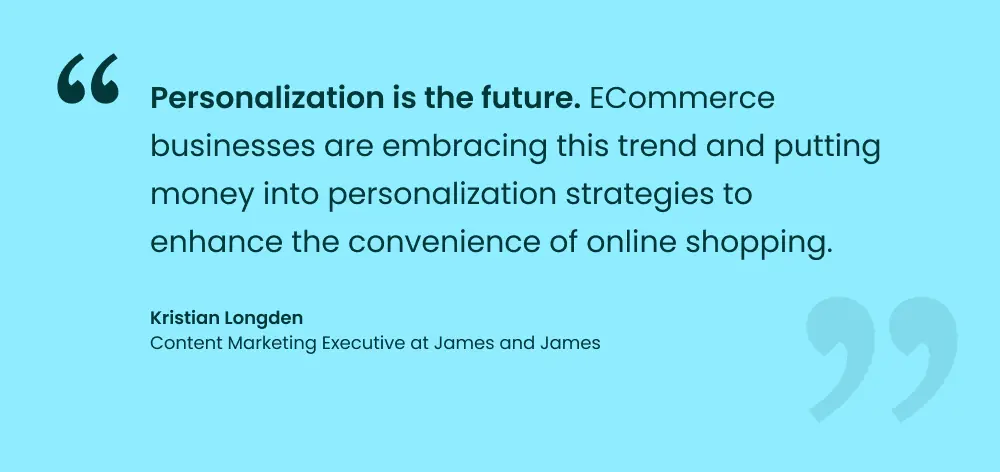
“Personalization is the future,” Content Marketing Executive at James and James Fulfillment Kristian Longden told us.
According to the data, personalization is indeed an important aspect of converting customers and increasing brand loyalty. In fact, according to one study, 66% of customers expect brands to understand their individual expectations and needs, and 52% expect offers to be personalized.
“You can make shopping more enjoyable and keep customers coming back by sending them personalized messages, giving them discounts that make sense, and connecting with them through, for example, video content,” said Kristian.
“By giving customers a personalized shopping experience, you can keep them coming back and make them more loyal to your brand,” he advised. “The majority of consumers think that if a retail business offered them a personalized experience, they would probably become repeat customers, proving that they actually want these kinds of interactions.”
Marketing professionals in the United States have reported a number of significant benefits from running personalized advertising campaigns, including an improved customer experience, increased conversion rates, increased visitor engagement, and more.
There’s no question that putting some effort into personalization is a good idea for eCommerce businesses in 2023. “ECommerce businesses are embracing this trend and putting money into personalization strategies to enhance the convenience of online shopping,” Kristian added. “This can entail tailoring email messages sent to specific recipients or giving the appropriate information to a certain customer group.”
6. Brands Will Need to Put Effort Into Data Security
Popular content
- 14 strategies to improve your eCommerce business’s financial health
- 50+ ChatGPT prompts to elevate your eCommerce business
- A guide to pricing your product on Amazon
- 5 marketing metrics all eCommerce businesses should track
- All about Amazon PPC
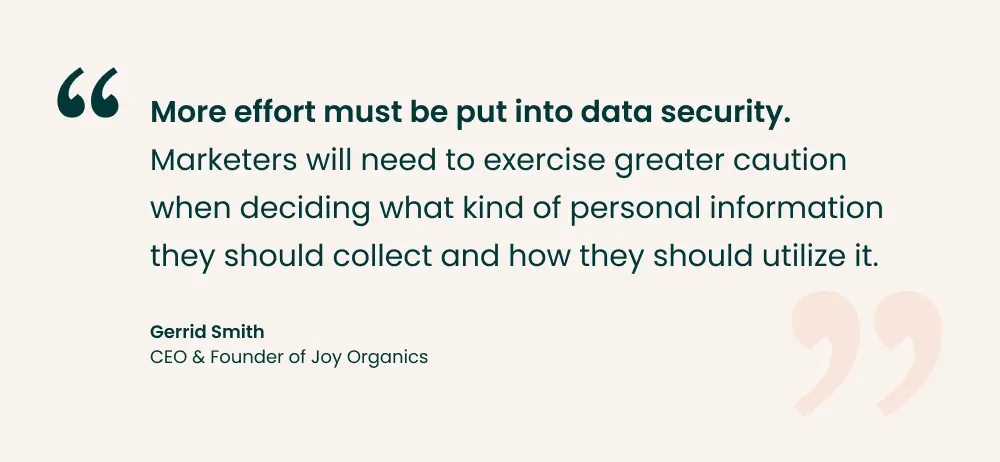
Despite the calls for a more personalized and targeted shopping experience, brands also need to remember that many consumers are concerned about privacy and data security. That means that while collecting certain data might be necessary for personalization, “more effort must be put into data security,” according to Gerrid Smith, the Founder and CEO of CBD product company Joy Organics.
In a study conducted by KPMG, 86% of consumers surveyed said their concern is growing regarding data privacy. 78% of respondents admitted to fear about the quantity of data being collected, too.
“There’s also the worry that their preferred online retailer would suffer a data breach, leaving them exposed if any of their information was stored there,” Gerrid added.
He therefore told us that companies will need to be more careful with customer data in 2023. “Marketers will need to exercise greater caution when deciding what kind of personal information they should collect and how they should utilize it,” he advised.
In order to ease consumer concerns and ensure that customers feel confident shopping with your brand, some changes might have to be made. “This could entail, for instance, not requiring account creation as a prerequisite to completing a purchase,” Gerrid explained. “Allow them to choose, at the very least. Just because a customer makes a one-time purchase from you doesn’t mean they want to be added to your email list.
7. Voice Search Will Grow in Popularity
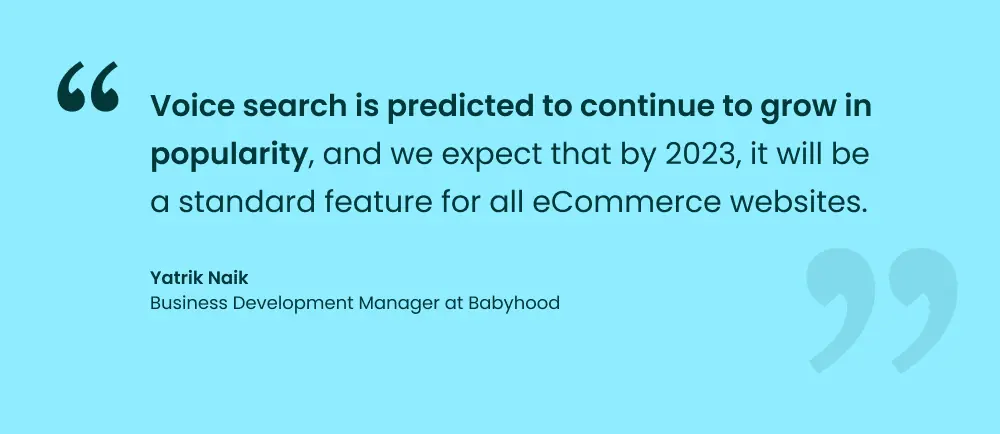
“I think that voice search will become the most common way to shop online in 2023,” Yatrik Naik, Business Development Manager at Babyhood, which sells nursery and baby products, predicted.
Voice search allows people to find information they need on the internet using only their voice. It’s convenient for many users and eliminates the need to type in a search field or scroll through results.
With the growing popularity of smart speakers and voice assistants like Siri, Alexa, Google Home, and more, consumers are starting to make purchases using voice search, too. “It’s possible that users might be more comfortable with this form of searching because they don’t have to type or scroll through results—they just tell their device what they want and expect it to go get it,” Yatrik speculated.
The increased use of mobile devices for online shopping is also contributing to the voice commerce trend. Consumers can now simply speak into their device and receive nearly any product they desire delivered directly to their home.
“We’ve seen it [voice search] become more popular and more accurate, over the past few years, with Amazon Echo and Google Home leading the charge,” Yatrik said. “Voice search is predicted to continue to grow in popularity, and we expect that by 2023, it will be a standard feature for all eCommerce websites.”
8. Everything Will Be Automated
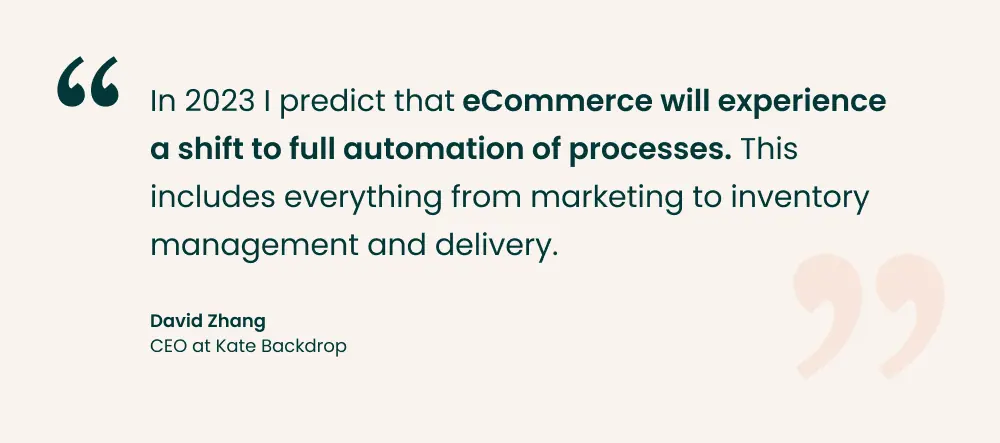
Automation, or the use of technology to perform a process with minimal human interaction, is a great way to save time and money while eliminating human error. When it comes to eCommerce, automation can be used for repetitive and tedious tasks such as inventory management, order flagging, communications, scheduled campaigns, customer segmentation, and more.
As the technology improves, more and more eCommerce sellers are using automation for their online stores. David Zhang, CEO of Kate Backdrop, predicts that this shift will continue in 2023.
“In 2023 I predict that eCommerce will experience a shift to full automation of processes,” he said. “This includes everything from marketing to inventory management and delivery.”
The advantages of automation are vast, and companies can greatly benefit from its adaptation. “Automation will help businesses streamline operations, reduce costs, and improve efficiency,” David clarified. “Overall, 2023 will be an exciting year for eCommerce as we move into a more automated and technology-driven world.”
9. Chatbots Will Communicate With Customers and Save Sales
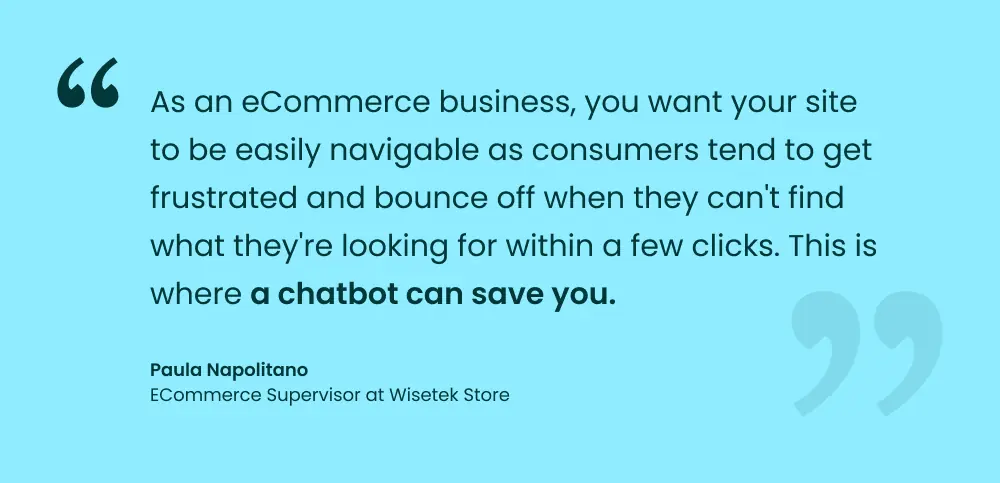
One form of automation that Paul Napolitano, eCommerce Supervisor at Wisetek Store, expects to see more often in 2023 is chatbots.
“Chatbots are something that we are actively exploring as they have a tendency to save potentially lost sales,” he told us. “By acting as a virtual sales assistant, these chatbots can save the day.”
A chatbot is a computer program that simulates human conversation. On an eCommerce website, customers can interact with chatbots to ask questions about products, find an item they’re looking for, or even get help with their order. This is a great way to save on customer service representatives and provide quick and easy assistance to consumers 24/7.
“Ideally as an eCommerce business you want your site to be easily navigable as consumers tend to get frustrated and bounce off when they can’t find what they’re looking for within a few clicks. This is where a chatbot can save you,” Paul explained. “Customers can type in what it is they’re looking for or answer a few prompts and be directed to where they need to go, a simple way to reduce cart abandonment and increase overall conversions.”
10. Customers Will Expect AR and Emerging Technologies on ECommerce Websites
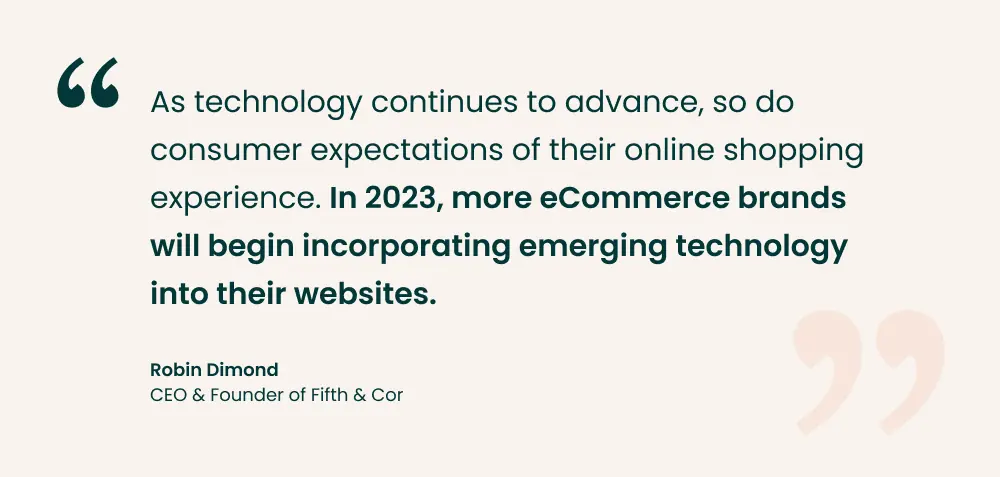
We mentioned virtual reality as a trend to look out for in 2023, but there are other emerging technologies that are playing a larger role in eCommerce, too. Utilizing such tech advancements will likely become crucial for eCommerce brands looking to keep up in the quickly changing space.
“In 2023, more eCommerce brands will begin incorporating emerging technology into their websites,” predicted Robin Dimond, CEO and Founder of marketing and innovation company Fifth & Cor. Not only will these technologies help brands run their businesses more efficiently, but customers are actually starting to expect it.
“As technology continues to advance, so do consumer expectations of their online shopping experience,” Robin said. This can include anything from automation to fast shipping to augmented reality, or AR, which can provide an improved shopping experience for online shoppers.
AR combines the real world and virtual content in order to give users a truly interactive experience. Unlike virtual reality, which immerses the user in a completely computer generated world, AR superimposes virtual elements onto the real world. This technology has many use cases for eCommerce. Customers can try on clothes or see how a product would look in their actual homes. They can test out different colors and sizes to see what a shirt will look like on their body or what a sofa will look like in their living room.
“Augmented reality experiences allow the consumer to virtually try on or see the product within the comfort of their own home,” Robin pointed out. “This allows increased confidence in the purchasing decision as well as a memorable brand experience.”
11. Live Shopping Will Be the Next Big Thing in ECommerce
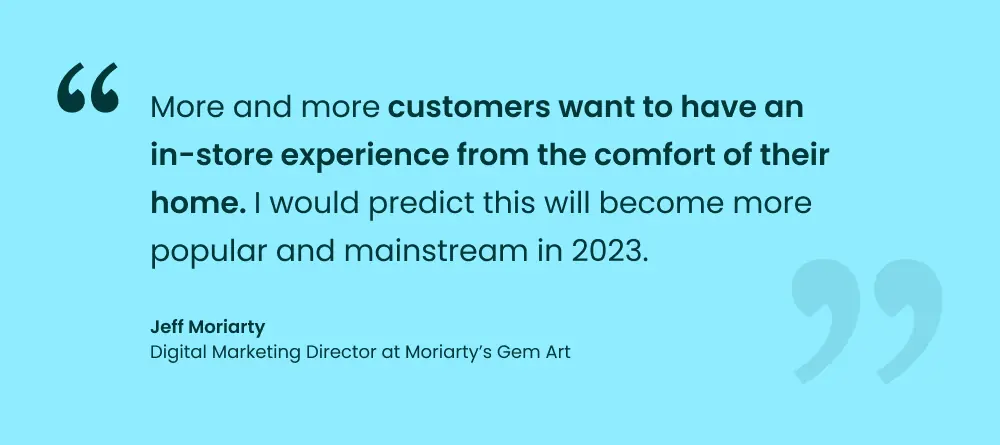
Live shopping is not a new idea. In fact, popular TV shopping channels such as the Home Shopping Network and QVC have been around since the early 1980s. The idea was simple: you watch live product demonstrations on television, call a number, and make a purchase. Viewers tuned in to see how a product really looked and worked before buying it quickly and easily from the comfort of their home.
More recently, live shopping has come to the world of eCommerce. Consumers watch a livestream and simultaneously have the opportunity to purchase the products displayed.
While it’s still relatively new to online stores in the US, it’s already a common practice in China. In fact, in 2020, two-thirds of surveyed Chinese consumers reported having purchased products through a livestream in the last year. ECommerce businesses in the United States are now beginning to understand that live shopping has great potential, and it’s predicted to hit $20 billion in revenue in 2022.
“One of the biggest jumps we saw this year with our business is through live online shopping,” Digital Marketing Director Jeff Moriarty revealed of his jewelry and gemstone business, Moriarty’s Gem Art. “More and more customers want to have an in-store experience from the comfort of their home.”
Live shopping gives them just that. “With platforms such as Shopify working together with YouTube to make this easier, I would predict this will become more popular and mainstream in 2023,” he said.
Jeff, for one, has already incorporated live shopping into his jewelry and gemstone business. “Our company started doing this at the beginning of 2022. We now do over $25,000 in sales each show and expect it to account for about 10% of our revenue in 2023.”
12. Online Payment Options Will Increase
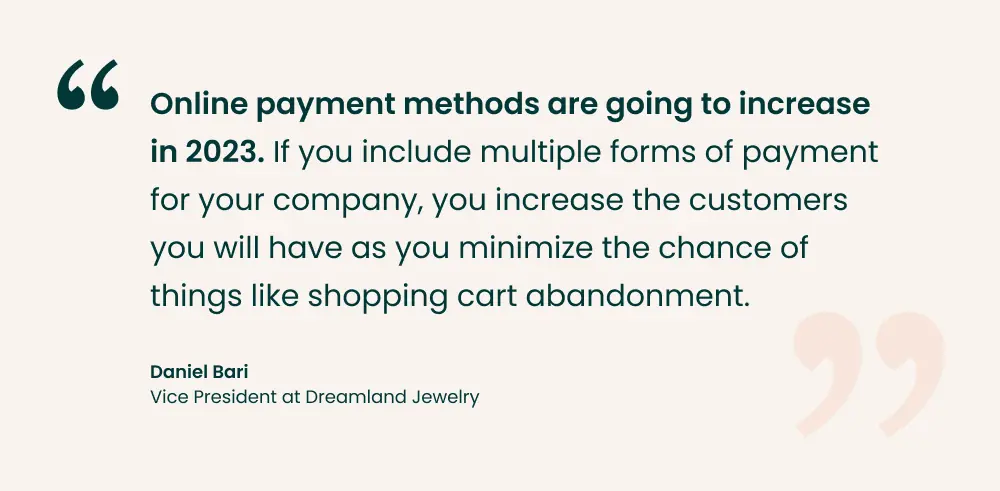
As speed and efficiency increase across the board, consumers are also looking for faster and easier ways to buy things. ECommerce already gives them the ability to make purchases from home, but when it comes to payment, things can get a bit more complicated.
Different customers prefer to pay using different methods, whether by credit or debit card, Apple Pay, PayPal, or any other type of payment. Sometimes a particular credit card won’t work for certain purchases, or a shopper will feel more secure using a service like PayPal.
In order to accommodate all of these different needs and desires, Daniel Bari, Vice President at Dreamland Jewelry, predicts that “the online payment methods are going to increase in 2023.”
“Consumers love convenience, as well as knowing their information is secure,” he explained. “Instead of only accepting credit cards, more eCommerce businesses will include alternative payment methods such as Apple Pay, PayPal, pay later options and possibly even other forms of currency like cryptocurrency.”
Making it easier for customers to complete a purchase can have many benefits for your business. “If you include multiple forms of payment for your company, you increase the customers you will have, as you are minimizing the chance of things like shopping cart abandonment,” said Daniel.
Accepting multiple forms of payment can encourage people to buy from your business and increase brand loyalty, too. “Customers like to be able to have options when it comes to paying online, and they also like that these forms of payment tend to be the most secure,” he added. “They can feel confident about spending their money with your online store.”
13. Payment Processes Will Be Faster
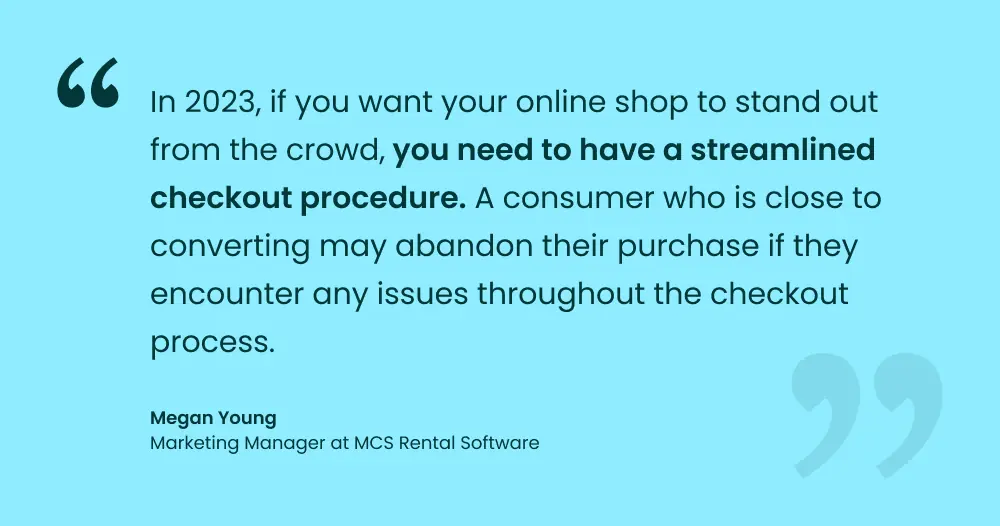
No online sale is complete until the payment process is complete. The longer the payment process takes, the more time a customer has to turn back and abandon their cart. Therefore, in 2023, streamlining your payment processes will be a necessity.
“Every customer’s journey includes payment processing, which is why it’s so important to your conversion rate,” Megan Young, Marketing Manager at MCS Rental Software, declared. “This is because consumers have the option to back out of a transaction right up until it is processed. A transaction is not finalized until the cash register beeps. So, it makes no difference whether you have successfully persuaded a lead to buy.”
ECommerce sellers can do everything right, including well targeted and personalized marketing campaigns, optimized product listings, and good quality products. But as long as their payment process isn’t working well, they’re bound to lose out on sales.
“A consumer who is close to converting may abandon their purchase if they encounter any issues throughout the checkout process,” added Megan. “An overly complicated checkout procedure is often identified as a leading cause of shoppers giving up on their carts.”
Avoiding this common issue should be a priority for sellers in the coming year. According to Megan, “in 2023, if you want your online shop to stand out from the crowd, you need to have a streamlined checkout procedure with many convenient payment methods.”
14. Artificial Intelligence and Machine Learning Will Be Widely Used
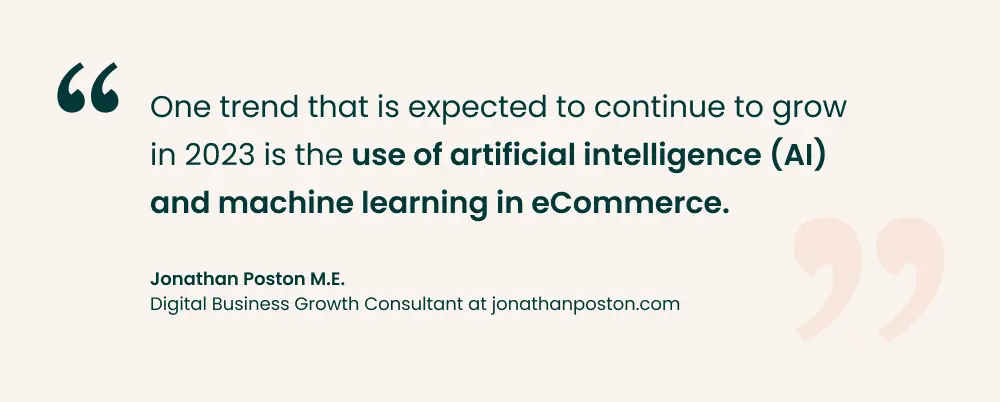
Artificial intelligence and machine learning can do a lot to improve customer experience and streamline sales for eCommerce businesses. Digital Business Growth Consultant Jonathan Poston predicts that the use of these technologies will spread in 2023. “One trend that is expected to continue to grow in 2023 is the use of artificial intelligence (AI) and machine learning in eCommerce,” he told us.
Artificial intelligence, or AI, is the ability for machines, usually computer systems, to carry out processes that normally require human intelligence. Machine learning is a subdivision of AI that uses data and algorithms to improve, or “learn”, getting more accurate and efficient over time.
Jonathan has seen the growth of these technologies through his work consulting at jonathanposton.com. “These technologies are already being used by many eCommerce companies to automate tasks, personalize the customer experience, and gain insights from data,” he said. “As AI and machine learning become more sophisticated and affordable, it is likely that their use in eCommerce will continue to increase.”
Through the use of AI and machine learning, eCommerce sellers can optimize their search engines, product recommendations, personalization, targeted advertisements, and more. All of this has the potential to increase conversion rates and improve customer experience, building brand loyalty and leading to happier customers.
Now’s the time for eCommerce businesses to adopt technologies such as AI and machine learning. “Overall, it is likely that in 2023, eCommerce will continue to be driven by advances in technology, and that companies that are able to effectively incorporate these technologies into their operations will be well-positioned for success,” Jonathan advised.
15. Omnichannel Retail Will Give Customers a Seamless Shopping Experience
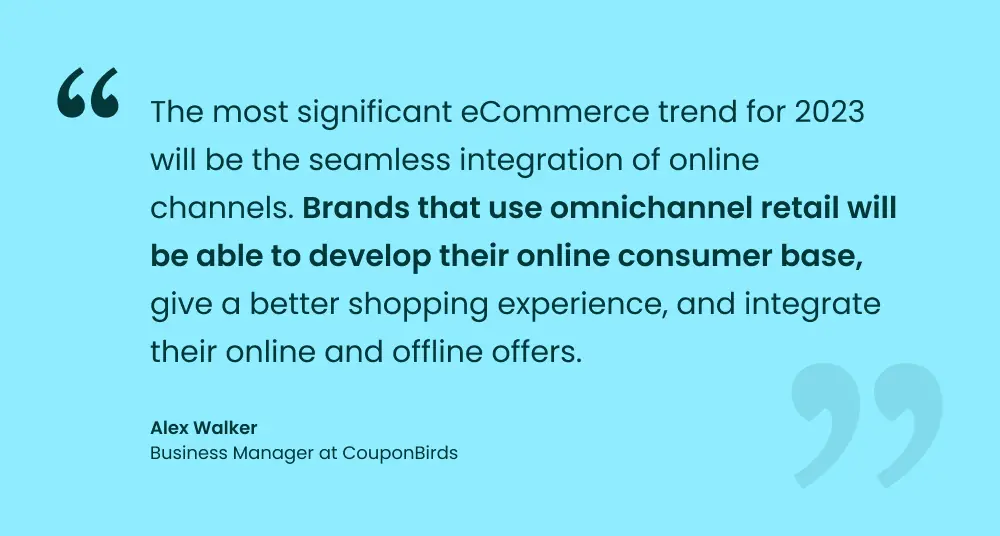
“The most significant eCommerce trend for 2023 will be the seamless integration of online channels,” Alex Walker, Business Manager at CouponBirds, predicted. This integration is known as omnichannel retail, and is becoming a must for eCommerce brands.
Omnichannel retail is a business model in which a retailer provides customers with a seamless, integrated, and consistent experience throughout all channels, whether they are shopping via desktop or mobile device, on any number of eCommerce platforms, in a brick-and-mortar store, or through a dedicated website.
In today’s modern world, where people will browse for items on a mobile device, make a purchase on a desktop computer, and pick it up in a brick-and-mortar store, omnichannel retail makes brands more accessible to all kinds of consumers. It connects all of these channels giving customers a seamless experience.
“This will see brands use social media, marketing, online storefronts, data, and commerce platforms to steer purchases and satisfy online and offline customer preferences,” Alex said. “Brands that use omnichannel retail will be able to develop their online consumer base, give a better shopping experience, and integrate their online and offline offers.”
16. Video Marketing Will Play a Big Role in ECommerce
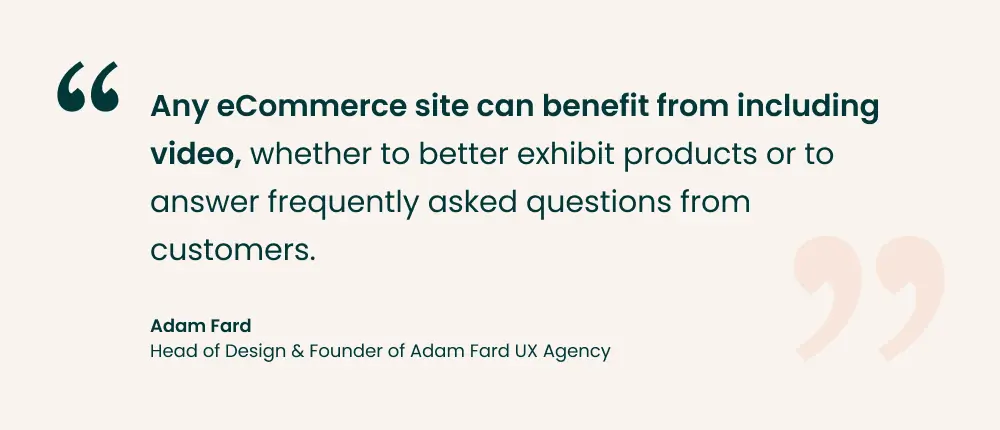
We live in a visual age. People consume video content nonstop on social media and YouTube, making video marketing a crucial aspect of advertising strategy. In fact, one study found that 73% of consumers prefer to learn about a product or service through a short video rather than reading an article, viewing infographics, downloading an eBook, or any other method. In addition, 88% of people report having been convinced to buy something after watching a video.
Adam Fard, Founder and Head of Design at Adam Fard UX Agency, predicts that videos will continue to be a big part of eCommerce marketing strategy in 2023.
“Including videos on our website and social media channels is a great way to attract and retain the attention of our target demographic,” he told us. “Any eCommerce site can benefit from including video, whether to better exhibit products or to answer frequently asked questions from customers.”
Video gives potential customers a better understanding of a product when they can’t actually see or touch it in person. In addition, showing the product in use gives customers a clearer idea of its size, features, and functionality. Video can also provide social proof, which often helps convince customers to make a purchase. Testimonials, user generated content, and influencer videos are great tools marketers can use to increase sales.
17. SEO Will Be a Cost-Effective Marketing Strategy
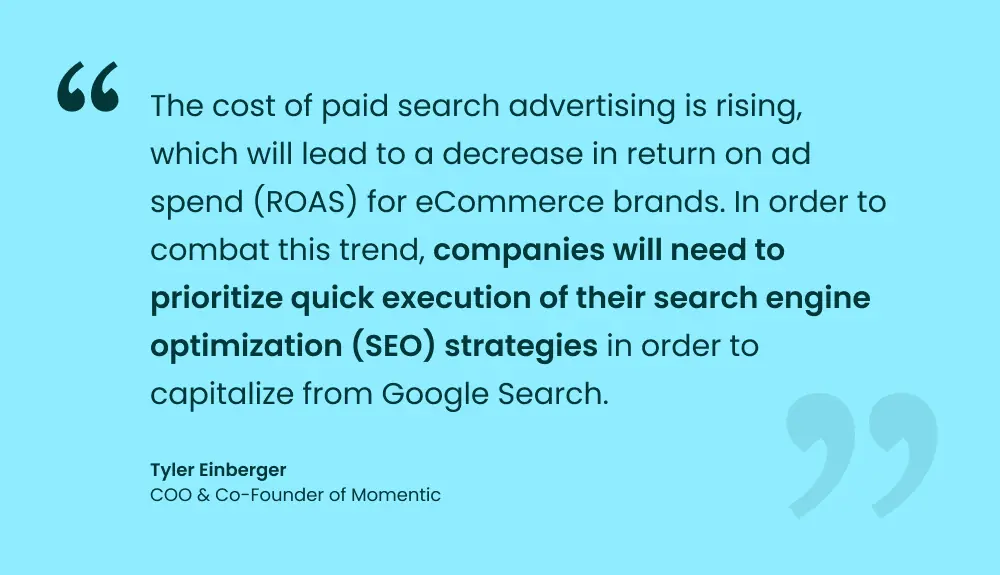
Marketing is an important part of running an eCommerce business, but it can get costly. PPC (pay-per-click) campaigns, social media ads, and influencer marketing can add up, and it’s never a good idea to overspend on marketing at the expense of other aspects of your business.
Due to the increasing price of paid advertising, Tyler Einberger, Co-Founder & COO at Momentic, predicts that eCommerce businesses will need to take a closer look at SEO, or search engine optimization.
“The cost of paid search advertising is rising, which will lead to a decrease in return on ad spend (ROAS) for eCommerce brands,” Tyler explained. “In order to combat this trend, companies will need to prioritize quick execution of their search engine optimization (SEO) strategies in order to capitalize from Google Search.”
SEO is the process of improving a website or page so it receives greater visibility and traffic from search engines. It’s a complex process, since it depends on a variety of factors including keywords, backlinks, and video, and must take into account changing search engine algorithms. However, if you put in the time and effort, SEO can pay off dramatically.
18. Decentralized Marketplaces Will Emerge
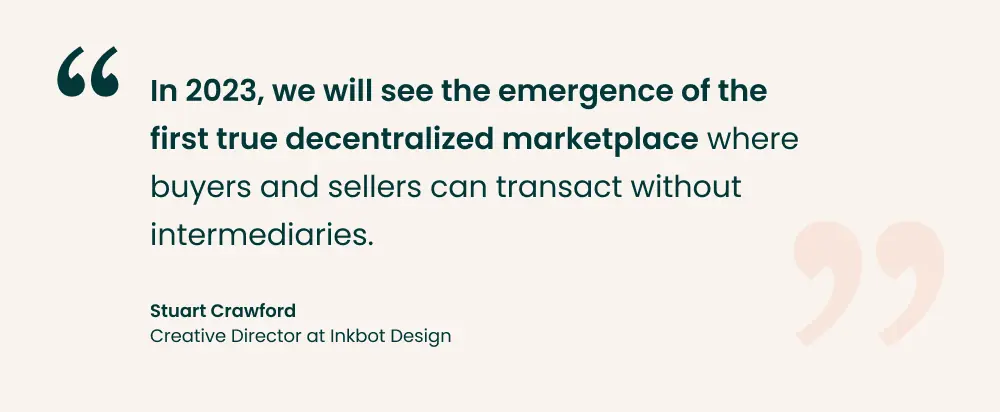
A decentralized marketplace is a marketplace in which sellers and buyers interact directly with each other instead of through a centralized exchange. Technology allows buyers and sellers to interact and communicate with each other from anywhere in the world without intermediaries or oversight from governing bodies or authorities.
Blockchain technology, which is becoming more widely used, makes this new type of marketplace possible. A blockchain is a distributed database or ledger that is shared across a computer network. Using such technology, it is possible to record and track transactions in a decentralized manner. That means that records on the blockchain are secure and trustworthy without the need for a third party or oversight.
According to Stuart Crawford, Creative Director at Inkbot Design, this is the future of eCommerce. “In 2023, we will see the emergence of the first true decentralized marketplace where buyers and sellers can transact without intermediaries,” he predicted.
“The technology behind blockchain allows for a new type of online marketplace that will completely change how people buy and sell things,” Stuart continued. “For now, there are many centralized platforms like Amazon and eBay where buyers and sellers connect with the platform’s mediators. But what if you could create an entire marketplace within a decentralized network? A marketplace that lets people directly interact with each other without any fees, third-party interference, or data breaches? The future of commerce is here, and it’s called blockchain technology.”
19. Recommerce Will Be a Big Trend
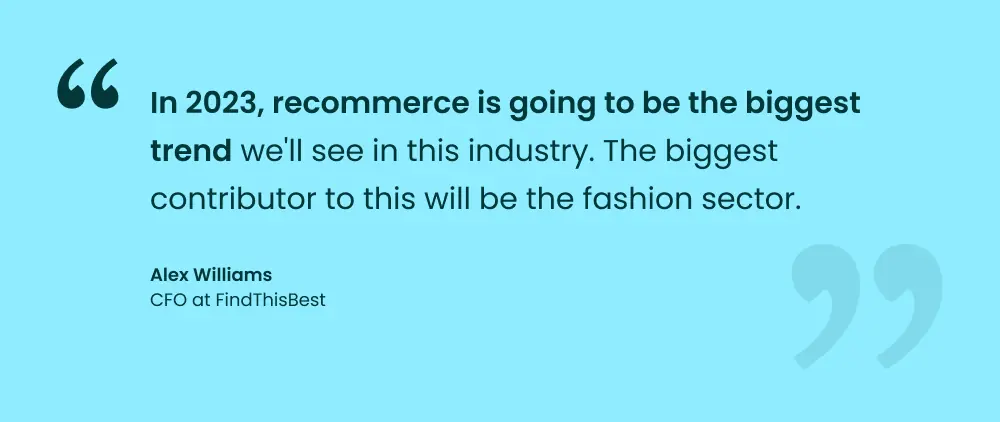
Recommerce, also called reverse commerce, is the practice of selling products that were previously owned. It’s a way to recycle products, extending their life and creating more sustainable practices.
Of course, the selling of second-hand products is not a new idea. We’ve all been to garage sales, second-hand stores, used book stores, and more. Now, however, it’s becoming more common to sell previously owned products online.
“In 2023, recommerce is going to be the biggest trend we’ll see in this industry,” Alex Williams forecasted. The CFO at FindThisBest, Alex sees this shift occurring largely in a specific industry.
“The biggest contributor to this will be the fashion sector,” he told us. “We’re moving toward the era of sustainability and away from fast fashion. As such, recommerce will play a massive role in this shift.”
As consumers demand more sustainable business practices, some brands are leading the way with recommerce. “Big brands like Levi’s have already started reselling old clothes as part of their sustainability practices,” Alex pointed out. “As more brands pivot to reselling, recommerce will emerge as the biggest trend in 2023.”
20. Brands Will Need to Optimize for Fast Performance
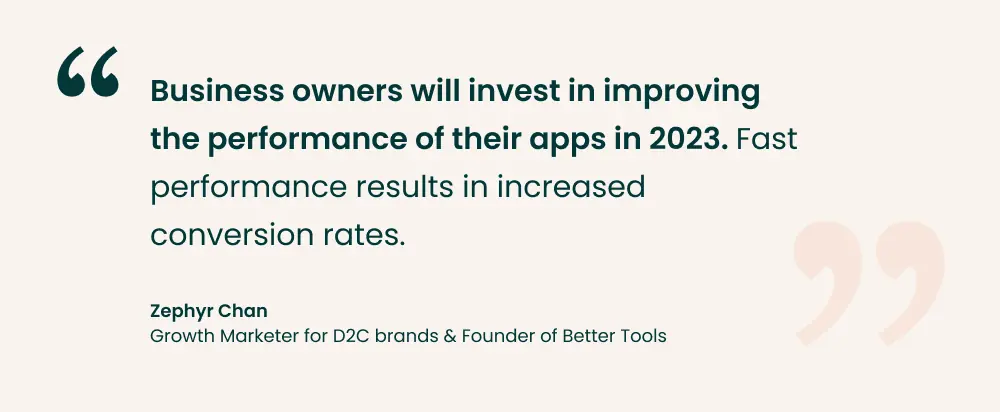
As technology advances, consumers expect websites and apps to work smoothly and quickly. This isn’t just a matter of preference – your sales depend on it. A Google study found that 54% of visitors to a mobile website navigate away from the page if it takes longer than 3 seconds to load.
That makes optimizing for performance a priority for eCommerce businesses. “Business owners will invest in improving the performance of their apps in 2023,” Zephyr Chan, Growth Marketer and Founder at Better Tools, stated.
It can be a challenge to improve your website’s load speed, but it can actually boost conversions. Simply by speeding up your page load time by one second, you can increase your conversions by 7%.
“No one likes slow performance,” Zephyr professed. “Fast performance results in increased conversion rates. This move will be pricey but worth every penny you will spend on its improvement.”
When launching a new website or app, it’s wise to make sure it’s working properly in advance. That will help you avoid unhappy customers, high bounce rates, and costly changes down the line.
“Before launching your eCommerce app, always speed test and check the performance,” advised Zephyr. “Make sure every aspect of the app delivers high functionality and instant results.”
21. SMS Marketing Will Take Off for Small Businesses
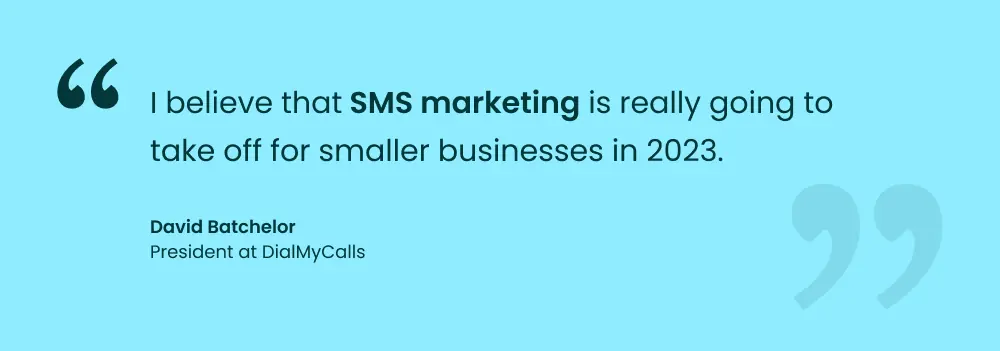
SMS, or text, marketing has increased in popularity over the last several years. More consumers than ever before are receptive to marketing texts from businesses. It’s a particularly effective method of reaching people, too, since 85% of consumers check their messages five minutes or less after receiving a text. Plus, SMS open rates are extremely high, with estimates as high as 98%.
David Batchelor, President at DialMyCalls, predicts that 2023 is the year that SMS marketing will reach the next level. “I believe that SMS marketing is really going to take off for smaller businesses in 2023,” he told us. “We’ve already seen it being implemented this year, but email marketing is still the focal point of their campaigns.”
While many businesses have an SMS marketing strategy in place, there’s still room for growth. In 2022, 55% of businesses sent text messages to their customers, while 70% of consumers opted in to receive such messages from at least one business. For those businesses that haven’t yet launched an SMS marketing campaign, 2023 might indeed be the year to get started.
“With affordable options and extremely high open rates (90+%), companies are going to start showing more attention to conducting SMS campaigns,” David predicted.
22. Subscription Business Models Will Be Popular
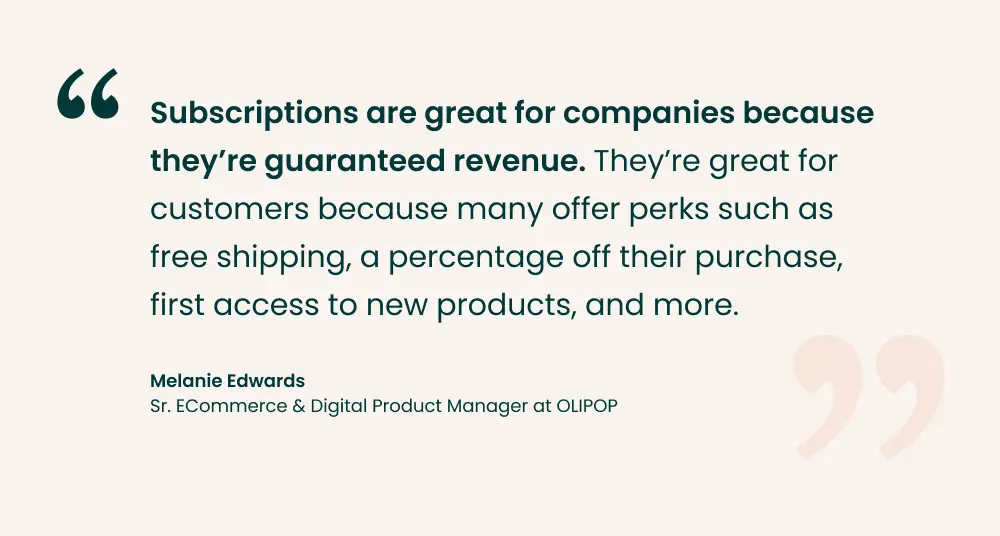
Subscription business models have a lot of benefits for everyone involved. As Melanie Edwards, Sr. ECommerce and Digital Product Manager at healthy soda company OLIPOP, put it, “Subscriptions are great for companies because they’re guaranteed revenue. They’re great for customers because many offer perks such as free shipping, a percentage off their purchase, first access to new products, and more.”
A subscription business model is a method of selling a product or service in which customers pay a recurring fee in exchange for said product or service. It’s a great way for businesses to retain customers and increase the lifetime value (LTV) of each customer.
There are all sorts of subscription business models out there, including popular streaming service Netflix, online storage on Apple iCloud or Google Drive, car subscription services, and more. When it comes to eCommerce products, many companies provide customers with a subscription to have products delivered to their homes over and over again. Birchbox and Dollar Shave Club are two examples, and many companies offer a monthly subscription box filled with goodies.
In 2023, Melanie predicts that “subscriptions will continue to be popular.
“If you’re not already offering a subscription service for your loyal customers, you should,” she advised.
23. Headless Commerce Will Take Over
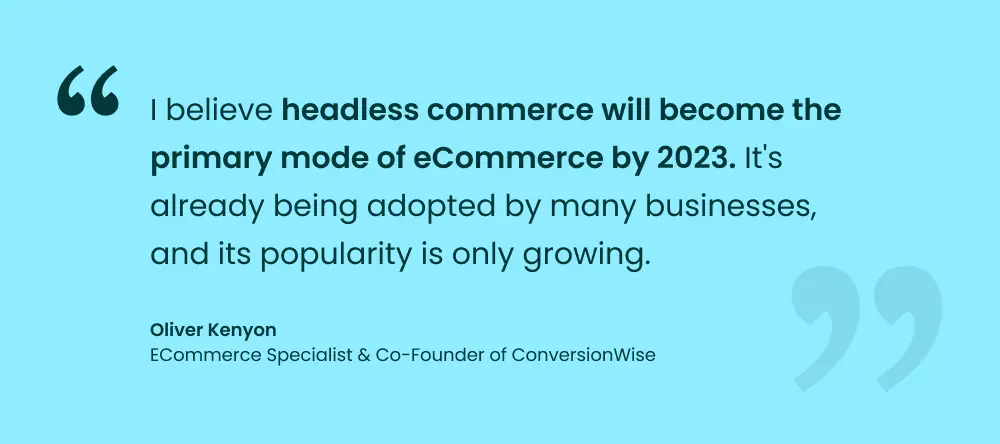
Headless commerce is a form of eCommerce in which the front end, or the part customers view and interact with, is separated from the back end, or the processes that allow your business to function, like the checkout. This makes it possible for businesses to make changes to the front end much more easily and quickly, enabling them to keep their user experience up to date.
“I believe headless commerce will become the primary mode of eCommerce by 2023,” Oliver Kenyon, ECommerce Specialist and Co-Founder at ConversionWise, told us. “It’s already being adopted by many businesses, and its popularity is only growing.״ Some of the best known headless commerce providers include Shopify, Magento, and BigCommerce.
In order for the front end and back end to work together seamlessly, headless commerce businesses use an API, or application programming interface. An API facilitates communication between separate pieces of software that a business uses to carry out different processes. That way, a business can choose to integrate a variety of tools that best serve its needs, such as a CMS (customer management system), CRM (customer relationship management), review service, and more.
“Headless commerce allows businesses to separate their websites’ content and presentation layers, giving them greater flexibility with their customer-facing digital experiences,” Oliver said. “This will enable businesses to optimize their sites faster and easier than ever before.”
Funding For Your 2023 Growth Goals
There sure is a lot going on in eCommerce as we enter 2023. If you need some extra working capital to achieve your eCommerce growth goals in the next year, look no further.
8fig is an eCommerce growth platform that gives sellers both the funding and the resources they need to take their businesses to the next level. Sign up for a free Growth Plan today to find out how 8fig can help your business grow!
Subscribe to the eCommerce newsletter for
top industry insights
to our blog
Read the latest
from 8fig

AI is quietly reshaping eCommerce. Karma’s Hadas Bar-Ad explores how today’s sellers are using intelligent tools to streamline operations, boost efficiency, and drive smarter growth.

WhatsApp isn’t just for memes and group chats anymore. With a 98% open rate, it’s the secret weapon your eCommerce marketing strategy might be missing. Here’s how to do it right.
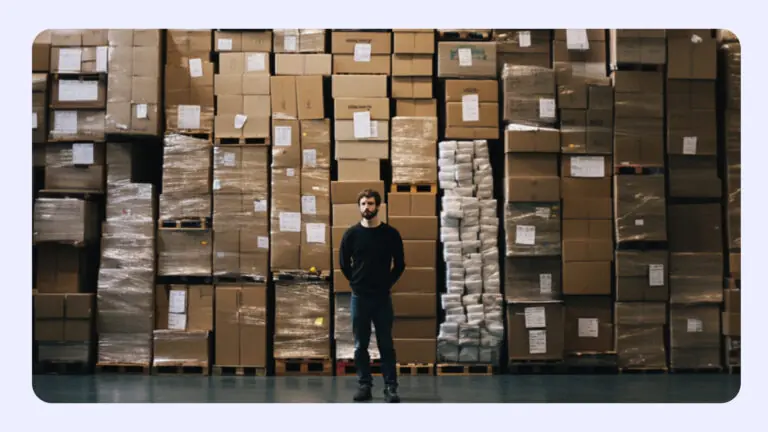
Stuck with extra inventory after Amazon’s Spring Sale? Learn five smart strategies to clear unsold stock, boost cash flow, and avoid future overstocks with smarter inventory planning.